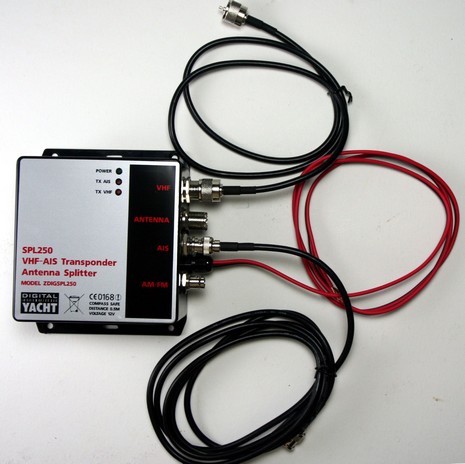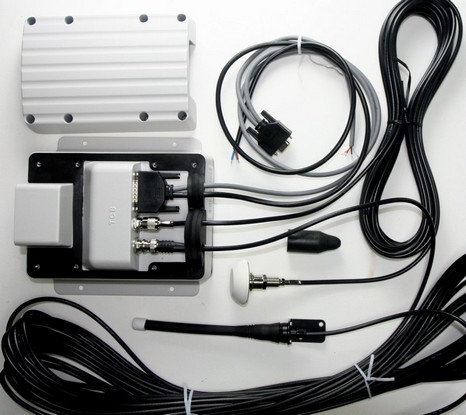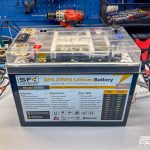Class B install #2, Digital Yacht bundles

Here’s Digital Yacht’s SPL250 VHF antenna splitter, purportedly the only splitter able to handle 2 watt Class B AIS and regular 25w VHF transceivers without smoke rising from either. (That’s supposedly true even if the splitter loses power, though I haven’t yet dared to test that feature.) It will significantly simplify some Class B installations, particularly here in the States where our VHF antennas and radios typically use PL-259 connectors, while most Class B VHF antenna inputs are BNC. That’s exactly how the SPL250 is set up and it even comes with those PL-259 and BNC patch cables. Check out Tim Flanagan’s Shine Micro AIS-BX install for a lesson on the value of a gadget like the SPL250.
On the other hand, Tim may get better performance by not using one antenna for both AIS B and VHF. The AIS definitely won’t receive or transmit when you’re talking on VHF, plus, at least theoretically, you lose some signal when you add connectors to its run. But I’ve been trying VHF and Class B transceivers alternately routed through the SPL250 and straight to the antenna, and so far have not seen a noticeable performance difference. Note that the $359 retail price of the SPL250 is not insignificant, though it’s only $200 if purchased along with Digital’s $899 AIT250 Class B, which is pictured below.
As you can see, the regular (without splitter) AIT250 package comes complete with compact GPS and AIS antennas sporting long cables (I’ll get the measurements) and copasetic BNC and TNC connectors. The transponder itself is exactly the same as Tim’s AIS-BX and also the True Heading AIS-CTRX. One other difference between the latter bundle and the AIT250, visible in the bigger photo, is that the data cable includes not just a DB9 plug for your boat’s PC but also four wires for a NMEA 0183 connection to your plotter (and heading sensor). I don’t know how Shine Micro sets up its data cable, but will try to find out, and do know that Shine offers a wide variety of AIS antennas. At any rate, it’s good to be down to install details like these, along with Class B friendly multiplexers and MMSI registrations.
True Heading, by the way, seems to market the same AIS antenna splitter in Europe, but doesn’t seem headed to the U.S. Digital Yacht, by contrast, is setting up an office in New Jersey and is already standing by 866–781–7015.














I heard that ICOM will “soon” have an integrated VHF / Class B AIS unit. That seems like a very clean way to solve the shared antenna issue.
Standard Horizon is supposed to be working on something as well.
Jon
Milltech Marine is now selling this same antenna splitter, only under the Comar label. In fact, Milltech has just become Comar’s master distributor in the U.S. and has already added a bunch of AIS receivers to its line, and I imagine Comar’s various transponders will be added once they get FCC certification.
Doug Miller also reports that the ACR Nauticast B’s that he’s already selling are going out the door “like hotcakes.” Cool!
http://www.milltechmarine.com
Naysayers still abound at SSCA, assuring each other that some AIS A units (per recent CG release) can’t see AIS B units or can turn them off at will. I recall some knowlegeable source here stating that an AIS B flag with MMSI and data will appear on older un-uped units, but I want to know 1> how big a problem is this, and 2> can or do Captains turn off AIS-B markers?
Thanks for your efforts over there, Sandy, but some folks just plain enjoy naysaying.
I don’t know how many AIS transponders and/or plotters are currently out there that can not interpret the Class B static data message, but the issue is fairly common. Those transponder displays and plotters do see a Class B target–i.e. the dynamic data–but not the vessel name, type, call sign, and size.
I think that’s what the USCG warning is mainly about, though there is a mention of older Class A displays that can not even see Class B dynamic data. I’ve never heard of that, and presume it’s quite rare.
The business of filtering out Class B targets is a mystery. While it seems quite possible to do in software, I don’t know of any AIS transponder or plotter that gives the viewer that choice. And I just checked the manual for the Furuno FA150 Class A transponder (no mention of Class B filtering).
So while naysayers persistently talk about filtering out Class B targets, I’ve never heard that it can be done, let alone is being done.
The Class B position report (msg18) IS listed in the original performance test standard for Class A units (IEC 61993-2 edition 1), therefore (in theory at least) ALL approved Class A units are capable of receiving a Class B position report (msg 18).
Like you, I am not aware of any display units that allow the user to filter out Class B reports.
There was a problem with one manufacturer’s AIS not receiving CSTDMA (Class B) transmissions because of a software bug. This was 2-3 years ago when CSTDMA was invented and as far as I know that was corrected by the manufacturer. And no, I don’t remember which one it was.